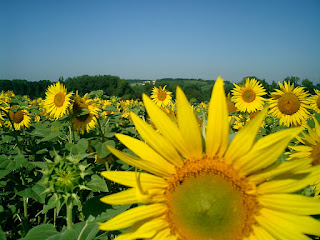 En cette période de Noël où il fait bon s’asseoir autour de la
cheminée en famille et se raconter de belles histoires, voici quelques contes
du Périgord.
En cette période de Noël où il fait bon s’asseoir autour de la
cheminée en famille et se raconter de belles histoires, voici quelques contes
du Périgord.
Le faucheur de Saint-Médard
Une femme riche et avare qui avait reçu le droit
de faucher autant de foin qu’elle le désirait dans une prairie avoisinante en l’espace de 24
heures uniquement, prit à son service un certain Médard, faucheur renommé, afin
d’accomplir cette tâche. Toutefois, elle
était mécontente de la lenteur de l’ouvrier qui ne semblait pas pressé pour se
mettre à la besogne, alors qu’elle le nourrissait gracieusement aux divers
repas de la journée. Médard implorait
calmement la patience de la riche femme et lui promettait que la fauche serait
finie « avec l’aide de Dieu ».
Malgré les promesses tenues de l’homme, la femme ne lui fit pas
confiance et refusa de le nourrir le dernier soir. L’histoire dit qu’une pluie forte tomba à ce
moment et pendant six semaines, pourrissant ainsi l’herbe fauchée par
Médard. Le dicton moderne est le
suivant : « S’il pleut à la St Médard (8 Juin), il pleut quarante
jours plus tard ».
La légende de la truffe
Une vieille femme errante et affamée, en Périgord,
fut charitablement accueillie par un bûcheron qui n’avait pourtant pas
grand-chose à lui offrir. Par
reconnaissance, la vieille dame qui s’était alors transformée en belle dame
couverte de richesses, transforma de sa baguette d’or une pomme de terre en « pomme
précieuse noire ». Après
s’être envolée par la cheminée sous forme d’une étincelle, le bûcheron
découvrit dans son jardin un grand nombre de « pommes précieuses
noires » au parfum si raffiné. Ces
petits trésors firent la richesse de l’homme et se répandirent dans tout le
Périgord. Telle est la légende de la
truffe du Périgord.



















